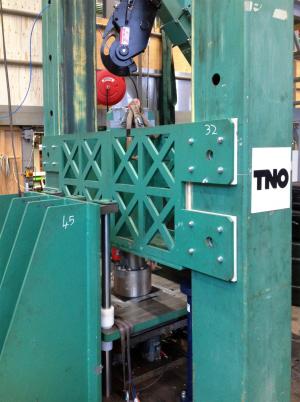Wham!
22 Jan 2015
-
Russell Eaton, Blanket Section
As part of an experimental program to test the robustness of various ceramic coatings, impact tests were carried out at TNO Structural Dynamics Laboratory in Delft, The Netherlands. Each pad was subjected 500 times to impacts of 2.5 MN, or the equivalent of 250 tonnes. Photo: TNO
In ITER, 440 blanket modules—consisting each of a first wall panel and a heavy shield block—will be bolted to the vacuum vessel wall. A number of customizable components such as bolt housings and key pads will be machined prior to assembly to achieve rigorous alignment tolerances for each module.
The key pads on the shield blocks interface with the keys on the vacuum vessel through which poloidal loads are transmitted. The pads need to be electrically insulated to help control current paths and restrict electromagnetic loads during ITER operation. This insulation is provided through an alumina coating on specific surfaces of the pads.
Because this coating has the potential to degrade due to cyclic and impact loads caused by off-normal events such as disruptions, an experimental program to test the robustness of various ceramic coatings has been undertaken, which includes static testing at the NIKIET institute in Russia (Moscow) and dynamic impact testing at the TNO Structural Dynamics Laboratory in The Netherlands (Delft).
For impact testing, insulating coatings were applied to 110 mm circular pads through three different processes: plasma spray, high velocity oxygen fuel, and detonation coating. Samples were subjected to 500 impacts using a drop test tower that simulated different loading events (see video link below). During the impact, each pad was loaded up to 2.5 MN (the equivalent of 250 tonnes or about the maximum landing weight of a Boeing 747-300).
Continuous electrical monitoring of each sample's insulating coating showed that all samples successfully survived without an electrical breakdown. The next step will now be for the supplier to confirm the preferred approach to applying this coating and to complete a final qualification program.
The key pads are part of the Procurement Arrangement signed between the ITER Organization and the Russian Domestic Agency on Blanket Connections (December 2014).
Watch a short clip on the testing of key pads at the TNO Structural Dynamics Laboratory


